Page 1437 of 3371
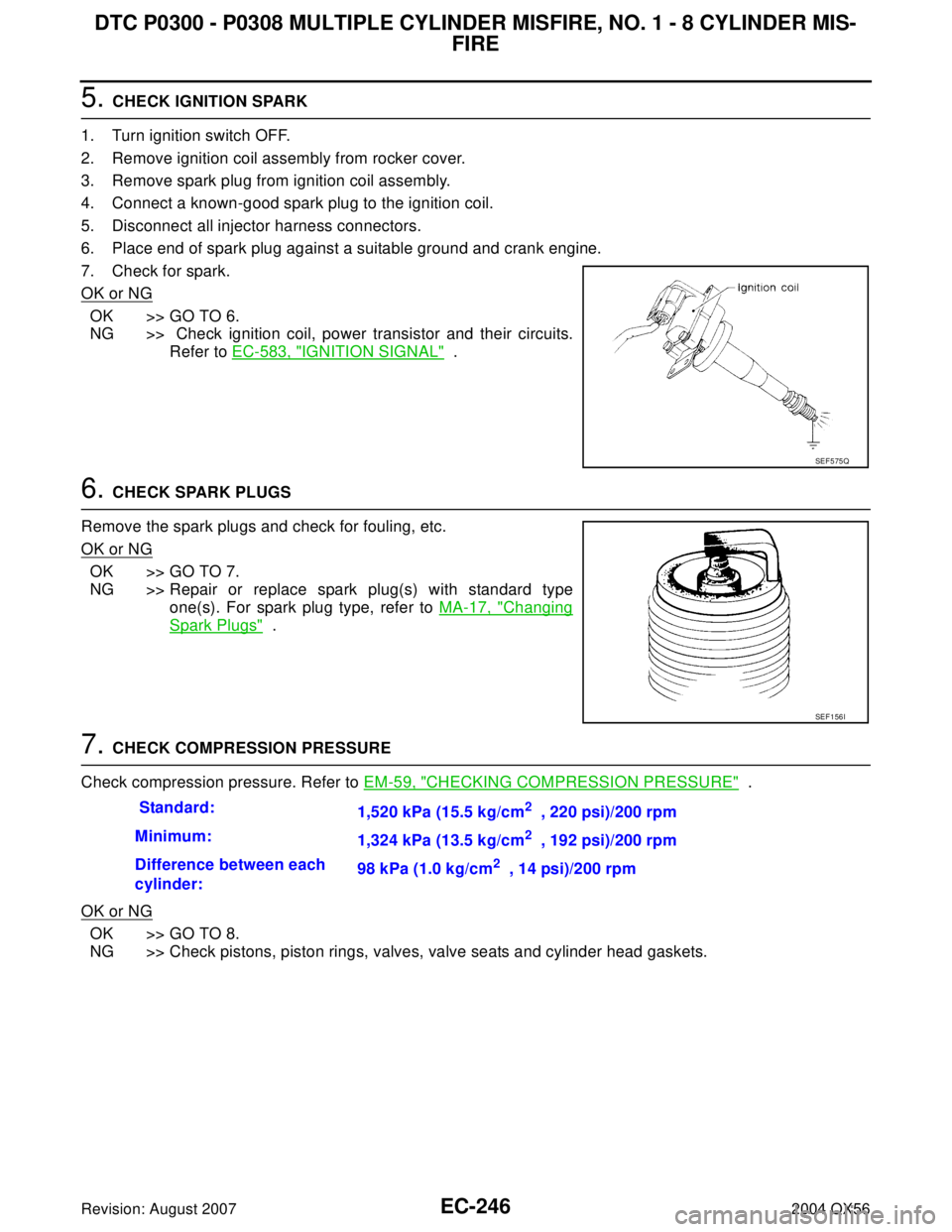
EC-246Revision: August 2007
DTC P0300 - P0308 MULTIPLE CYLINDER MISFIRE, NO. 1 - 8 CYLINDER MIS-
FIRE
2004 QX56
5. CHECK IGNITION SPARK
1. Turn ignition switch OFF.
2. Remove ignition coil assembly from rocker cover.
3. Remove spark plug from ignition coil assembly.
4. Connect a known-good spark plug to the ignition coil.
5. Disconnect all injector harness connectors.
6. Place end of spark plug against a suitable ground and crank engine.
7. Check for spark.
OK or NG
OK >> GO TO 6.
NG >> Check ignition coil, power transistor and their circuits.
Refer to EC-583, "
IGNITION SIGNAL" .
6. CHECK SPARK PLUGS
Remove the spark plugs and check for fouling, etc.
OK or NG
OK >> GO TO 7.
NG >> Repair or replace spark plug(s) with standard type
one(s). For spark plug type, refer to MA-17, "
Changing
Spark Plugs" .
7. CHECK COMPRESSION PRESSURE
Check compression pressure. Refer to EM-59, "
CHECKING COMPRESSION PRESSURE" .
OK or NG
OK >> GO TO 8.
NG >> Check pistons, piston rings, valves, valve seats and cylinder head gaskets.
SEF 5 75 Q
SEF 1 56 I
Standard:
1,520 kPa (15.5 kg/cm2 , 220 psi)/200 rpm
Minimum:
1,324 kPa (13.5 kg/cm
2 , 192 psi)/200 rpm
Difference between each
cylinder:98 kPa (1.0 kg/cm
2 , 14 psi)/200 rpm
Page 1438 of 3371
DTC P0300 - P0308 MULTIPLE CYLINDER MISFIRE, NO. 1 - 8 CYLINDER MIS-
FIRE
EC-247
C
D
E
F
G
H
I
J
K
L
MA
EC
Revision: August 20072004 QX56
8. CHECK FUEL PRESSURE
1. Install all removed parts.
2. Release fuel pressure to zero. Refer to EC-46, "
FUEL PRESSURE RELEASE" .
3. Install fuel pressure gauge and check fuel pressure. Refer to EC-47, "
FUEL PRESSURE CHECK" .
OK or NG
OK >> GO TO 10.
NG >> GO TO 9.
9. DETECT MALFUNCTIONING PART
Check the following.
�Fuel pump and circuit (Refer to EC-601, "FUEL PUMP CIRCUIT" .)
�Fuel pressure regulator (Refer to EC-47, "FUEL PRESSURE CHECK" .)
�Fuel lines
�Fuel filter for clogging
>> Repair or replace.
10. CHECK IGNITION TIMING
Check the following items. Refer to EC-79, "
Basic Inspection" .
OK or NG
OK >> GO TO 11.
NG >> Follow the EC-79, "
Basic Inspection" . At idle: Approx. 350 kPa (3.57 kg/cm
2 , 51
psi)
Items Specifications
Target idle speed 650 ± 50 rpm (in P or N position)
Ignition timing 15 ± 5° BTDC (in P or N position)
Page 1439 of 3371
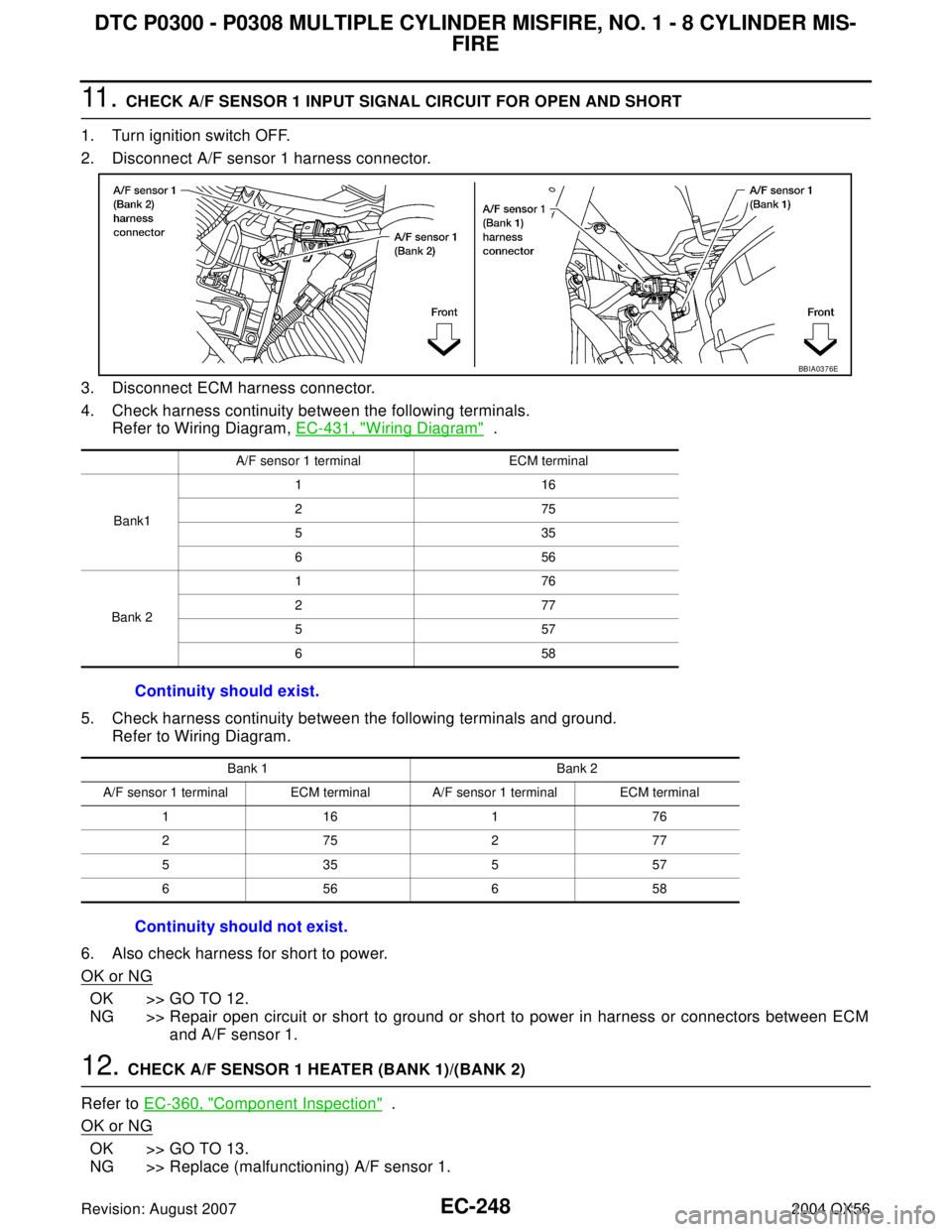
EC-248Revision: August 2007
DTC P0300 - P0308 MULTIPLE CYLINDER MISFIRE, NO. 1 - 8 CYLINDER MIS-
FIRE
2004 QX56
11 . CHECK A/F SENSOR 1 INPUT SIGNAL CIRCUIT FOR OPEN AND SHORT
1. Turn ignition switch OFF.
2. Disconnect A/F sensor 1 harness connector.
3. Disconnect ECM harness connector.
4. Check harness continuity between the following terminals.
Refer to Wiring Diagram, EC-431, "
Wiring Diagram" .
5. Check harness continuity between the following terminals and ground.
Refer to Wiring Diagram.
6. Also check harness for short to power.
OK or NG
OK >> GO TO 12.
NG >> Repair open circuit or short to ground or short to power in harness or connectors between ECM
and A/F sensor 1.
12. CHECK A/F SENSOR 1 HEATER (BANK 1)/(BANK 2)
Refer to EC-360, "
Component Inspection" .
OK or NG
OK >> GO TO 13.
NG >> Replace (malfunctioning) A/F sensor 1.
A/F sensor 1 terminal ECM terminal
Bank1116
275
535
656
Bank 2176
277
557
658
Continuity should exist.
Bank 1 Bank 2
A/F sensor 1 terminal ECM terminal A/F sensor 1 terminal ECM terminal
116176
275277
535557
656658
Continuity should not exist.
BBIA0376E
Page 1441 of 3371
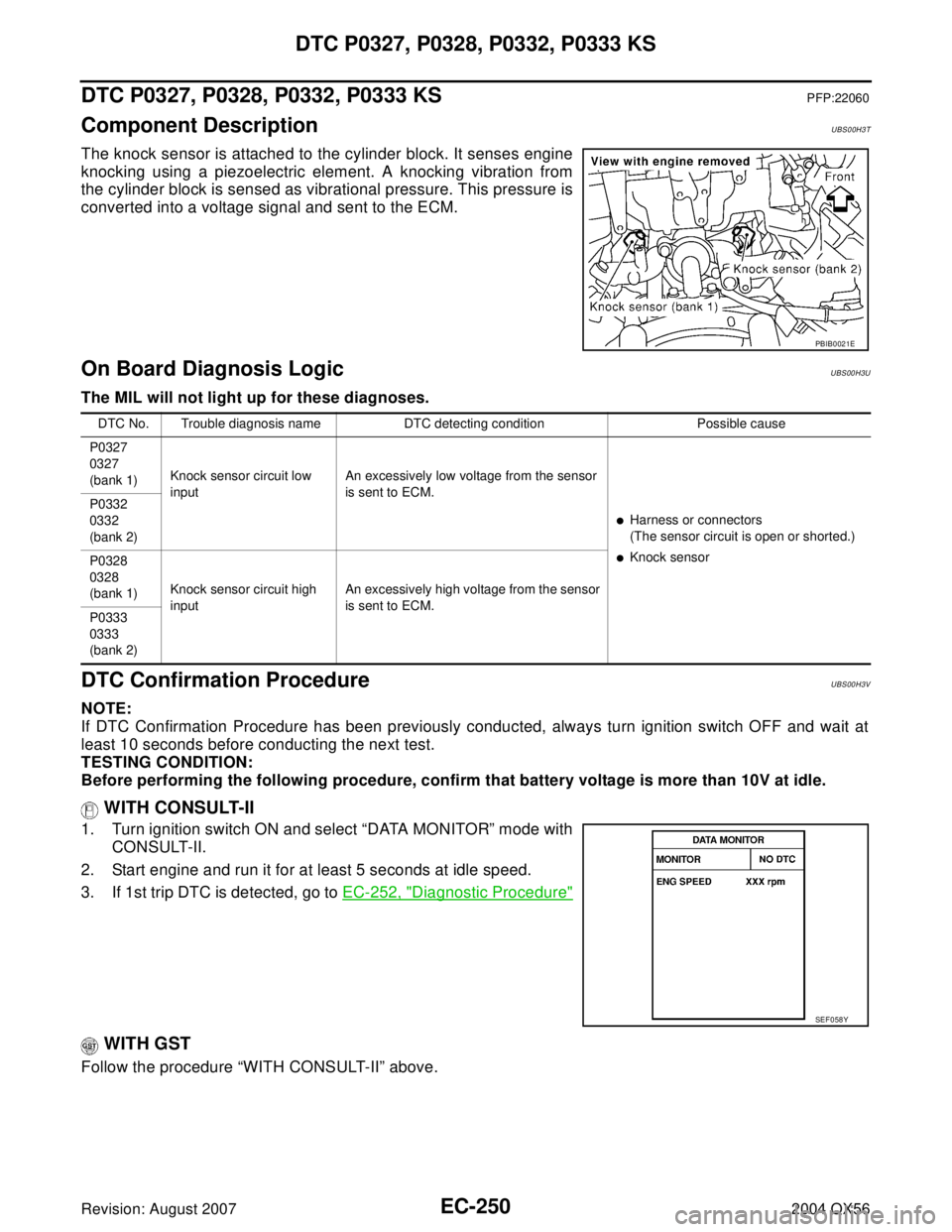
EC-250Revision: August 2007
DTC P0327, P0328, P0332, P0333 KS
2004 QX56
DTC P0327, P0328, P0332, P0333 KSPFP:22060
Component DescriptionUBS00H3T
The knock sensor is attached to the cylinder block. It senses engine
knocking using a piezoelectric element. A knocking vibration from
the cylinder block is sensed as vibrational pressure. This pressure is
converted into a voltage signal and sent to the ECM.
On Board Diagnosis LogicUBS00H3U
The MIL will not light up for these diagnoses.
DTC Confirmation ProcedureUBS00H3V
NOTE:
If DTC Confirmation Procedure has been previously conducted, always turn ignition switch OFF and wait at
least 10 seconds before conducting the next test.
TESTING CONDITION:
Before performing the following procedure, confirm that battery voltage is more than 10V at idle.
WITH CONSULT-II
1. Turn ignition switch ON and select “DATA MONITOR” mode with
CONSULT-II.
2. Start engine and run it for at least 5 seconds at idle speed.
3. If 1st trip DTC is detected, go to EC-252, "
Diagnostic Procedure"
WITH GST
Follow the procedure “WITH CONSULT-II” above.
PBIB0021E
DTC No. Trouble diagnosis name DTC detecting condition Possible cause
P0327
0327
(bank 1)Knock sensor circuit low
inputAn excessively low voltage from the sensor
is sent to ECM.
�Harness or connectors
(The sensor circuit is open or shorted.)
�Knock sensor P0332
0332
(bank 2)
P0328
0328
(bank 1)Knock sensor circuit high
inputAn excessively high voltage from the sensor
is sent to ECM.
P0333
0333
(bank 2)
SEF 0 58 Y
Page 1443 of 3371
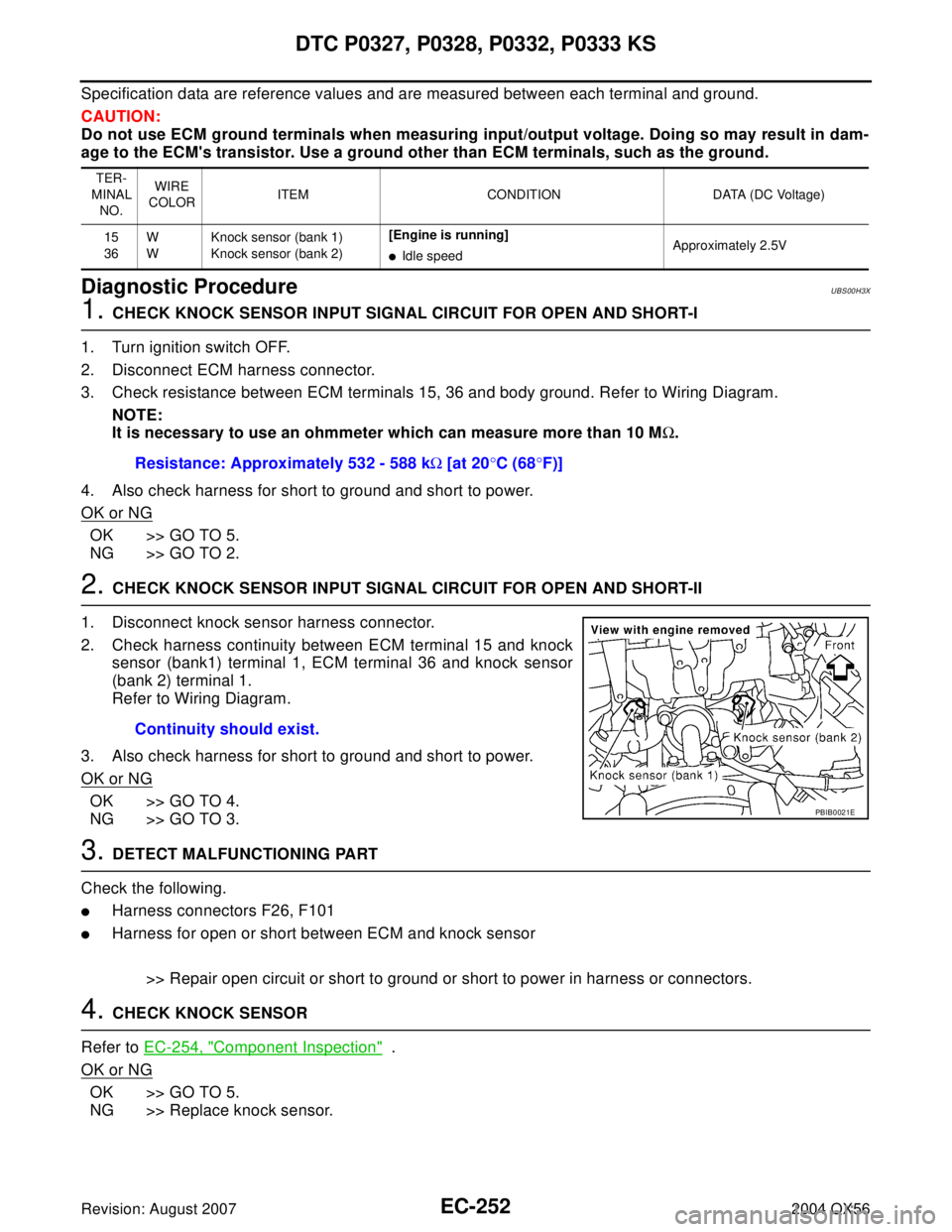
EC-252Revision: August 2007
DTC P0327, P0328, P0332, P0333 KS
2004 QX56
Specification data are reference values and are measured between each terminal and ground.
CAUTION:
Do not use ECM ground terminals when measuring input/output voltage. Doing so may result in dam-
age to the ECM's transistor. Use a ground other than ECM terminals, such as the ground.
Diagnostic ProcedureUBS00H3X
1. CHECK KNOCK SENSOR INPUT SIGNAL CIRCUIT FOR OPEN AND SHORT-I
1. Turn ignition switch OFF.
2. Disconnect ECM harness connector.
3. Check resistance between ECM terminals 15, 36 and body ground. Refer to Wiring Diagram.
NOTE:
It is necessary to use an ohmmeter which can measure more than 10 MΩ.
4. Also check harness for short to ground and short to power.
OK or NG
OK >> GO TO 5.
NG >> GO TO 2.
2. CHECK KNOCK SENSOR INPUT SIGNAL CIRCUIT FOR OPEN AND SHORT-II
1. Disconnect knock sensor harness connector.
2. Check harness continuity between ECM terminal 15 and knock
sensor (bank1) terminal 1, ECM terminal 36 and knock sensor
(bank 2) terminal 1.
Refer to Wiring Diagram.
3. Also check harness for short to ground and short to power.
OK or NG
OK >> GO TO 4.
NG >> GO TO 3.
3. DETECT MALFUNCTIONING PART
Check the following.
�Harness connectors F26, F101
�Harness for open or short between ECM and knock sensor
>> Repair open circuit or short to ground or short to power in harness or connectors.
4. CHECK KNOCK SENSOR
Refer to EC-254, "
Component Inspection" .
OK or NG
OK >> GO TO 5.
NG >> Replace knock sensor.
TER-
MINAL
NO.WIRE
COLORITEM CONDITION DATA (DC Voltage)
15
36W
WKnock sensor (bank 1)
Knock sensor (bank 2)[Engine is running]
�Idle speedApproximately 2.5V
Resistance: Approximately 532 - 588 kΩ [at 20°C (68°F)]
Continuity should exist.
PBIB0021E
Page 1444 of 3371
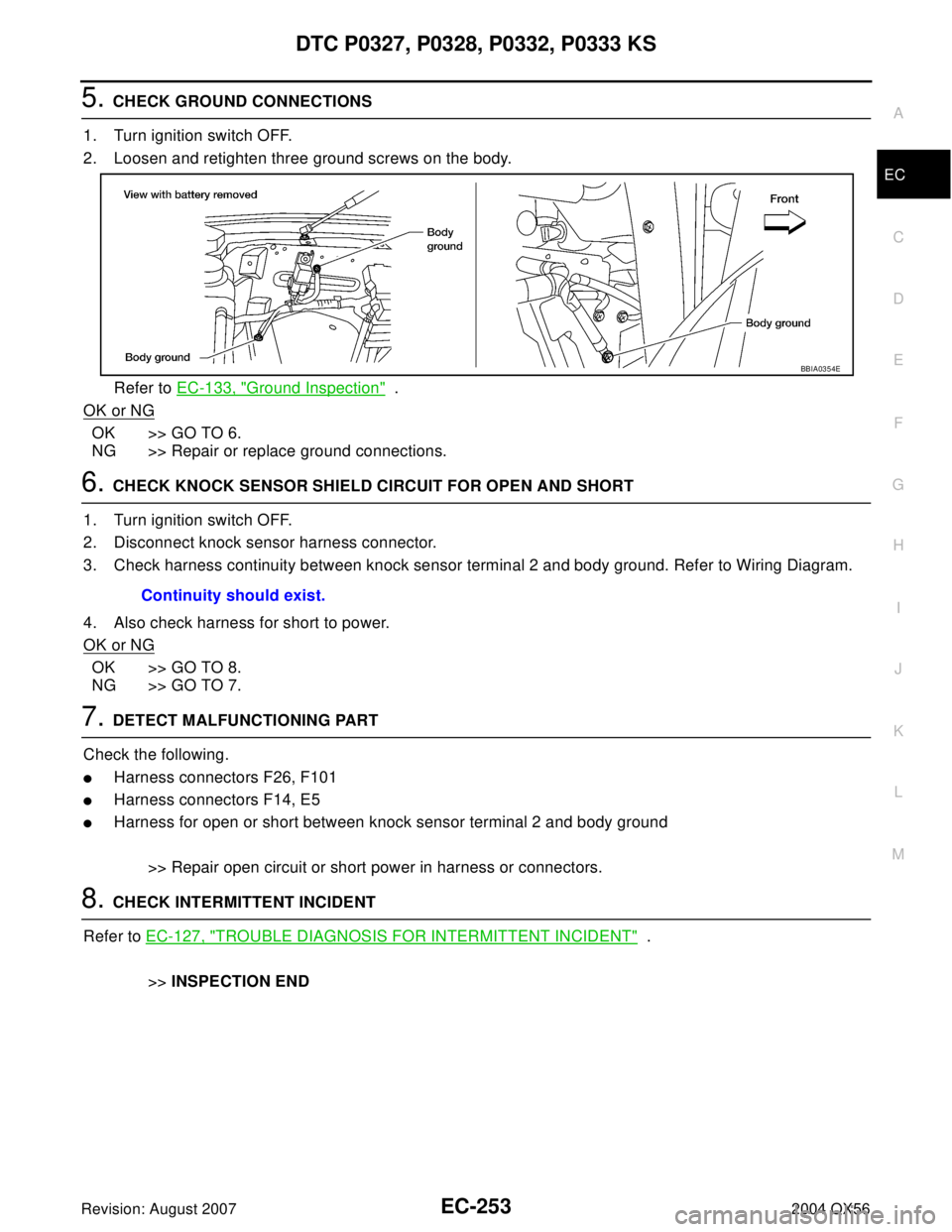
DTC P0327, P0328, P0332, P0333 KS
EC-253
C
D
E
F
G
H
I
J
K
L
MA
EC
Revision: August 20072004 QX56
5. CHECK GROUND CONNECTIONS
1. Turn ignition switch OFF.
2. Loosen and retighten three ground screws on the body.
Refer to EC-133, "
Ground Inspection" .
OK or NG
OK >> GO TO 6.
NG >> Repair or replace ground connections.
6. CHECK KNOCK SENSOR SHIELD CIRCUIT FOR OPEN AND SHORT
1. Turn ignition switch OFF.
2. Disconnect knock sensor harness connector.
3. Check harness continuity between knock sensor terminal 2 and body ground. Refer to Wiring Diagram.
4. Also check harness for short to power.
OK or NG
OK >> GO TO 8.
NG >> GO TO 7.
7. DETECT MALFUNCTIONING PART
Check the following.
�Harness connectors F26, F101
�Harness connectors F14, E5
�Harness for open or short between knock sensor terminal 2 and body ground
>> Repair open circuit or short power in harness or connectors.
8. CHECK INTERMITTENT INCIDENT
Refer to EC-127, "
TROUBLE DIAGNOSIS FOR INTERMITTENT INCIDENT" .
>>INSPECTION END
BBIA0354E
Continuity should exist.
Page 1446 of 3371
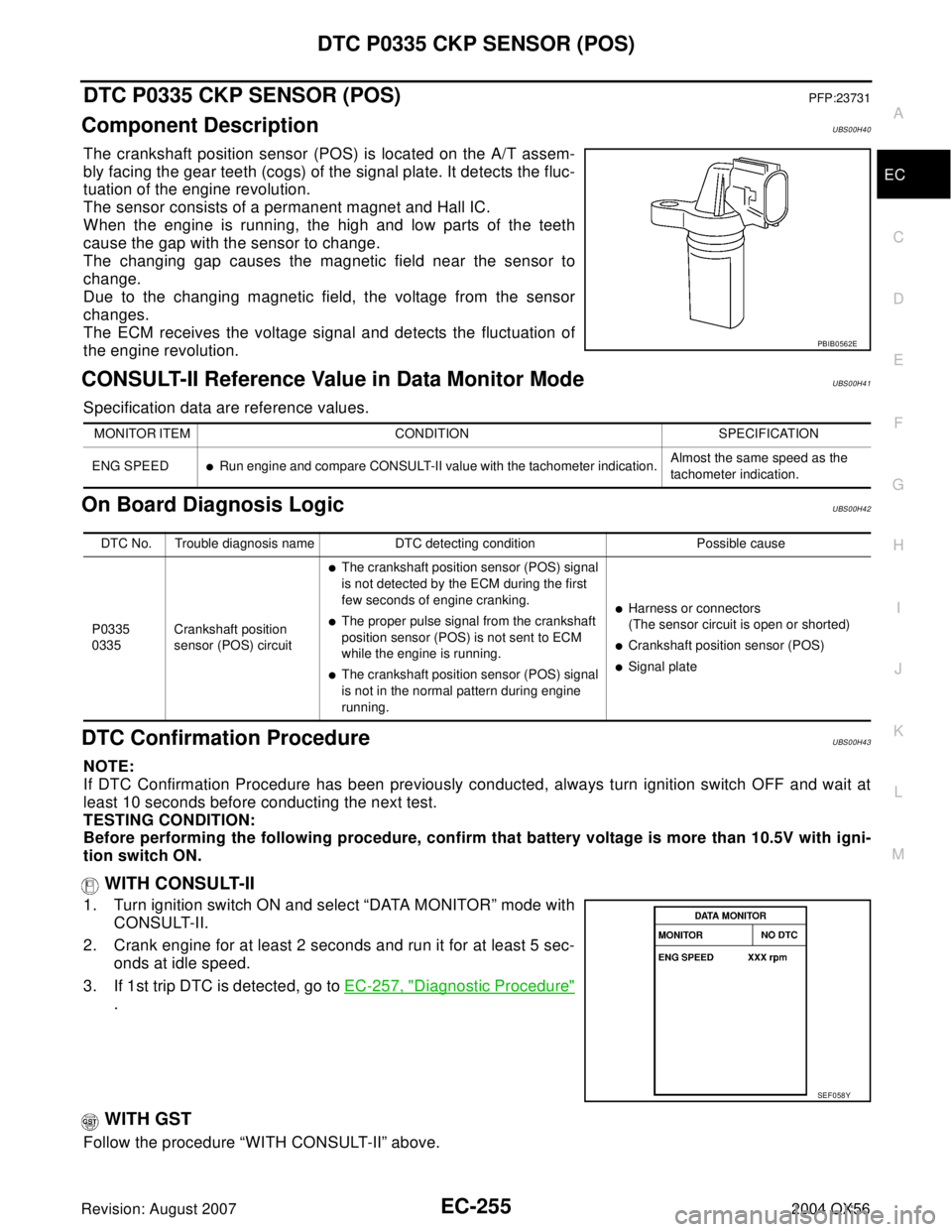
DTC P0335 CKP SENSOR (POS)
EC-255
C
D
E
F
G
H
I
J
K
L
MA
EC
Revision: August 20072004 QX56
DTC P0335 CKP SENSOR (POS)PFP:23731
Component DescriptionUBS00H40
The crankshaft position sensor (POS) is located on the A/T assem-
bly facing the gear teeth (cogs) of the signal plate. It detects the fluc-
tuation of the engine revolution.
The sensor consists of a permanent magnet and Hall IC.
When the engine is running, the high and low parts of the teeth
cause the gap with the sensor to change.
The changing gap causes the magnetic field near the sensor to
change.
Due to the changing magnetic field, the voltage from the sensor
changes.
The ECM receives the voltage signal and detects the fluctuation of
the engine revolution.
CONSULT-II Reference Value in Data Monitor ModeUBS00H41
Specification data are reference values.
On Board Diagnosis LogicUBS00H42
DTC Confirmation ProcedureUBS00H43
NOTE:
If DTC Confirmation Procedure has been previously conducted, always turn ignition switch OFF and wait at
least 10 seconds before conducting the next test.
TESTING CONDITION:
Before performing the following procedure, confirm that battery voltage is more than 10.5V with igni-
tion switch ON.
WITH CONSULT-II
1. Turn ignition switch ON and select “DATA MONITOR” mode with
CONSULT-II.
2. Crank engine for at least 2 seconds and run it for at least 5 sec-
onds at idle speed.
3. If 1st trip DTC is detected, go to EC-257, "
Diagnostic Procedure"
.
WITH GST
Follow the procedure “WITH CONSULT-II” above.
PBIB0562E
MONITOR ITEM CONDITION SPECIFICATION
ENG SPEED
�Run engine and compare CONSULT-II value with the tachometer indication.Almost the same speed as the
tachometer indication.
DTC No. Trouble diagnosis name DTC detecting condition Possible cause
P0335
0335Crankshaft position
sensor (POS) circuit
�The crankshaft position sensor (POS) signal
is not detected by the ECM during the first
few seconds of engine cranking.
�The proper pulse signal from the crankshaft
position sensor (POS) is not sent to ECM
while the engine is running.
�The crankshaft position sensor (POS) signal
is not in the normal pattern during engine
running.
�Harness or connectors
(The sensor circuit is open or shorted)
�Crankshaft position sensor (POS)
�Signal plate
SEF 0 58 Y
Page 1448 of 3371
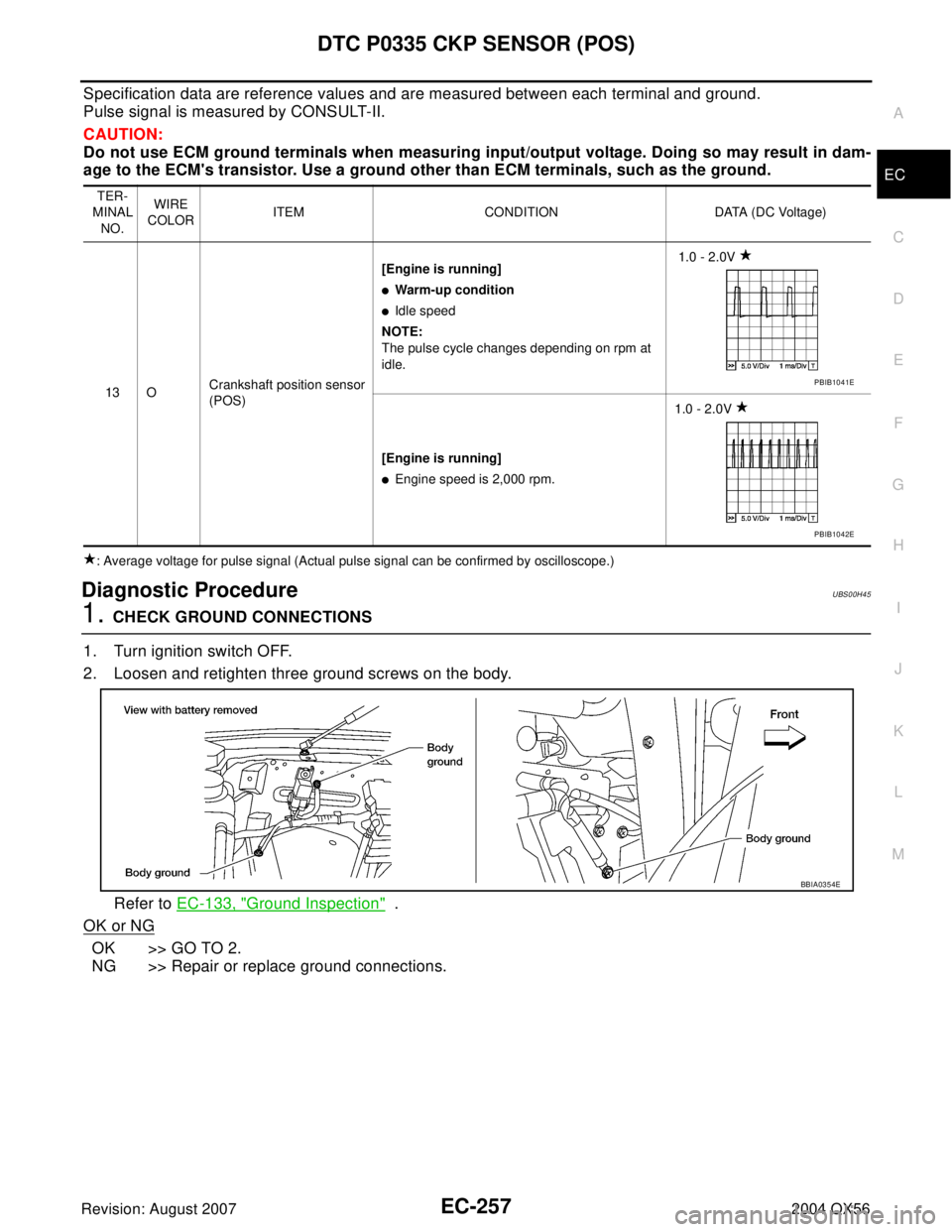
DTC P0335 CKP SENSOR (POS)
EC-257
C
D
E
F
G
H
I
J
K
L
MA
EC
Revision: August 20072004 QX56
Specification data are reference values and are measured between each terminal and ground.
Pulse signal is measured by CONSULT-II.
CAUTION:
Do not use ECM ground terminals when measuring input/output voltage. Doing so may result in dam-
age to the ECM's transistor. Use a ground other than ECM terminals, such as the ground.
: Average voltage for pulse signal (Actual pulse signal can be confirmed by oscilloscope.)
Diagnostic ProcedureUBS00H45
1. CHECK GROUND CONNECTIONS
1. Turn ignition switch OFF.
2. Loosen and retighten three ground screws on the body.
Refer to EC-133, "
Ground Inspection" .
OK or NG
OK >> GO TO 2.
NG >> Repair or replace ground connections.
TER-
MINAL
NO.WIRE
COLORITEM CONDITION DATA (DC Voltage)
13 OCrankshaft position sensor
(POS)[Engine is running]
�Warm-up condition
�Idle speed
NOTE:
The pulse cycle changes depending on rpm at
idle. 1.0 - 2.0V
[Engine is running]
�Engine speed is 2,000 rpm.1.0 - 2.0V
PBIB1041E
PBIB1042E
BBIA0354E